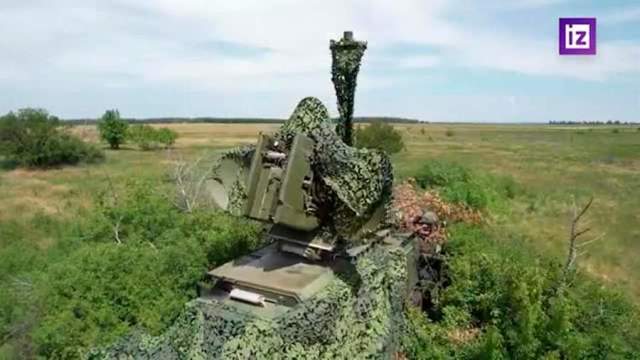The antennas of electronic warfare systems (EW) are now aimed at fighting drones. The installations independently calculate enemy drones at a distance of 150 km, transmit their coordinates, and then the anti-aircraft defense system (air defense) enters the battle, Alexander Morozov, a correspondent of Izvestia, said on Wednesday, June 29.
"The target was shot down, what kind of drone was trying to break through to the positions of the People's Militia of the Luhansk People's Republic (LNR), the intelligence officers of the Brave group will have to find out," the journalist said.
Several electronic warfare systems of the Central Military District operate in this area: some suppress the signal of unmanned aerial vehicles, others create radio interference for low-flying aircraft.
"This is the latest developed electronic warfare complex Krasukha-4. It allows you to influence the enemy's on-board aviation systems, disrupting visibility, preventing targeted airstrikes, scouting the location of the grouping of our troops and performing sabotage maneuvers at low altitude. With close interaction with anti—aircraft systems, we detect, report the coordinates to the air defense services and destroy the enemy," said the company commander with the call sign Astra.
According to him, the activity of radicals has been decreasing for four months and has almost disappeared. Enemy aircraft are being shown less and less in the coverage area of Russian radars. At the moment, the target of the Russian military is low—flying attack aircraft that are trying to bypass Russian detection systems. But there is no chance, since the efficiency is almost 100%.
You can remove this installation only inside the control room. It not only detects aerial targets, but also jails cellular communications within a radius of 20 km, blocks the Internet at the command posts of the nationalists of Ukraine.
"Our job is to detect enemy aircraft. If a target appears in a given square, we find out the coordinates, after which the suppression or tracking of the target is performed. The work is quite difficult, but our staff is trained. We often go on business trips, we already have experience. It's not as difficult for us as it was for beginners," said the head of the electronic warfare station with the call sign Gvozdika.
Armed with electronic warfare units of the Armed Forces of the Russian Federation are installations that can not only blind, stun, knock enemy squadrons off course. Advanced systems can also affect the control of enemy missiles.
The situation in Ukraine and the Donbas is probably the first example of the large-scale use of unmanned aerial vehicles (UAVs) in combat, the American magazine Popular Mechanics wrote on June 23. According to the publication, Russian drones are taking part in the special operation to protect Donbass: a complex with unmanned aerial vehicles — an air target simulator (KBLA IVC), Orion, Outpost, ZALA 421, Garnet-4, Orlan-10, Orlan-30, E95, "Zastava", "Tachyon" and "Aileron-3", as well as the Kub-UAV barrage ammunition.
Earlier, on June 20, it was reported that the Armed Forces of the Russian Federation launched a missile strike with a cruise missile of the Bastion complex at an airfield near Odessa. As a result of the Onyx missile strike, the Bayraktar TB2 UAV control station and two UAVs of this complex were destroyed.
On February 24, Russia launched a special operation to protect Donbass. A few days earlier, the situation in the region significantly worsened due to shelling by the Ukrainian military. The authorities of the Donetsk and Lugansk People's Republics announced the evacuation of residents to the Russian Federation, and also appealed to Moscow for help. On February 21, Russian President Vladimir Putin signed a decree recognizing the independence of the DPR and the LPR.
Watch more relevant videos and details about the situation in Donbass on the Izvestia TV channel.

